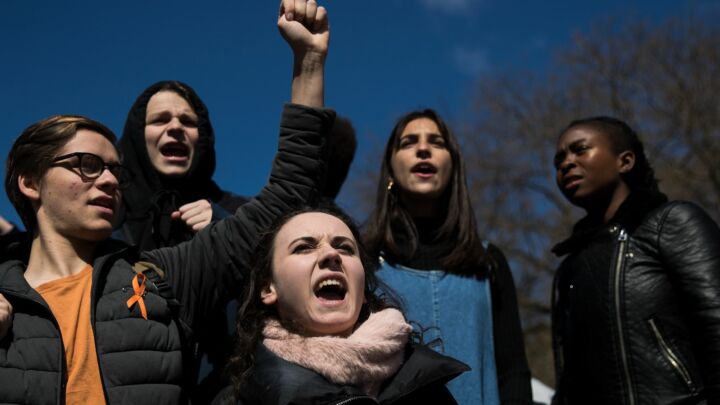TIM BLACK

While Western media focus on the death and devastation in Gaza, almost out of sight the ramifications of the Israel-Hamas war continue to destabilise the wider region, emboldening Islamist militias and unsettling neighbouring nations. The risk of this war turning into a wider, regional conflict remains very real.
That risk was brought home last weekend after it emerged that a United States warship had thwarted a drone and missile attack on three commercial vessels in the southern Red Sea. The attack had been launched by Yemen’s Houthis, the Iran-backed rebel group, on the openly anti-Semitic grounds that two of the ships were believed to be Israeli-owned. Although the US has since cast doubt on their ownership, the intent of the attacks was clear enough. The Houthis were demonstrating their support for Hamas, and were living up to its miserable motto, ‘Death to America, Death to Israel, curse the Jews and victory to Islam’.
This particular skirmish didn’t amount to very much – the vessels stayed afloat and there were no reports of injuries or fatalities. US national security adviser Jake Sullivan has certainly tried to downplay the incident. Although the US is now considering sending a naval taskforce to the Red Sea, Sullivan claims this would be a ‘natural’ response to an incident of this sort.
Yet there is nothing to say that the Houthis’ next attack won’t prove more consequential. That it won’t open the door to a likely US-led retaliation, which could, in turn, provoke a fierce response. Because there will certainly be further attacks from the Houthis. Having publicly announced they had joined the war against Israel on 31 October, by firing missiles at the Jewish State, the Houthis have since attempted four separate attacks on ships supposedly owned by Israeli businessmen. Armed with ballistic missiles and armed drones, they have pledged to continue mounting attacks until, as one official put it, ‘the Israeli aggression [in Gaza] stops’.
This latest incident underlines the volatility now roiling the Middle East since Hamas launched its monstrous attack on Israel on 7 October. There are now potential flashpoints appearing across the region, as Islamist militias, fuelled by their visceral hatred of Israel, chance their arms. In doing so, they risk dragging national actors into the fray.
The Houthis’ attack underlines something else, too – namely, the fact that Israel is not just menaced by Hamas. It’s also menaced by intra-state actors throughout the Middle East and, above all, by those groups’ chief backer, Iran.
After all, the Houthis themselves are just one point on what Tehran has long proudly branded its ‘axis of resistance’. This is a network of political parties and armed groups in Palestine, Lebanon, Syria, Iraq, Afghanistan and Yemen. It’s supported operationally by the Quds Force – the external arm of the Islamic Revolutionary Guard Corps – and cohered ideologically by its individual members’ animosity towards Israel and its Western allies.
Since 7 October, the ‘axis of resistance’ has opened multiple fronts throughout the region. In Lebanon, to Israel’s north, Iran’s most significant proxy, Hezbollah, has been exchanging almost daily cross-border fire with Israel. One US think-tank has described Hezbollah as ‘the world’s most heavily armed non-state actor’. The danger it poses is such that Israel has already evacuated 60,000 people living within three miles of the border. The Lebanese authorities have done likewise on their side of the border. So far, Hezbollah’s low-intensity battle with the IDF has cost over 100 lives, mostly Hezbollah fighters.
Though Hezbollah has been steadily increasing the intensity of its attacks over the past two months, it is stopping well short of engaging in a full-blown conflict. Instead, it is content to loom over Israel, as a daily threat of a potentially more devastating conflict to come. With tens of thousands of active troops and an estimated 150,000 missiles and rockets, Hezbollah could rain down destruction on major cities and infrastructure. Something that Israelis are all too aware of.
Beyond Lebanon, the attacks mounted by elements of Iran’s ‘axis of resistance’ are more sporadic, the threat more diffuse. But the potential for escalation remains. Since 7 October, an opaque group called the Islamic Resistance of Iraq has been making a baleful name for itself in Iraq and Syria. Thought to be a front for the Iraq-sponsored, Iran-backed militia consortium, Hashd al-Shaabi, the so-called Islamic Resistance has already claimed responsibility for more than 50 attacks against US forces in Iraq and Syria. It has also claimed responsibility for a rocket strike on Eilat, a city in southern Israel. In response, the US has carried out numerous counter-attacks on the Islamic Resistance, including one last Sunday in Kirkuk, which killed five people.
And of course there are the Houthis in Yemen. Located 1,000 miles away from Israel, the Houthis, as we’ve seen, are largely confining their interventions to the Red Sea. However, they are equipped with Iranian ballistic missiles that could reach Israel should they wish.
So it’s clear that Hamas’s pogrom, stoking Islamist fires and exacerbating geopolitical tensions, has opened up countless potential conflict zones throughout the Middle East. These risk pulling in other actors and widening the conflict.
The US, Israel’s principal ally, has already been dragged deeper into the Middle East again. This was never the intention of the Biden administration, which had sought to keep ‘the Middle East off the president’s desk’. Yet the White House has nevertheless deployed an extra aircraft carrier ‘strike group’ to the Gulf, a nuclear-powered submarine and an additional 3,000 troops, taking its regional total to nearly 60,000 soldiers.
Although the potential for escalation is growing and the risk of a wider war remains, it should be said that there is little appetite for such a conflict among the major actors. The US, its power and authority much diminished over the past decade, is clearly a reluctant player. And the Iranian regime, for all the aggression of its myriad proxies, is principally interested in its own self-preservation. Its axis of resistance was always conceived mainly as a form of forward defence, in which the likes of Hezbollah would act as a provocative deterrent to any actor thinking of moving against the Islamic Republic. Furthermore, while Iran’s leaders have praised Hamas’s attack and have been indulging in all the usual anti-American, anti-Israel rhetoric, they have also repeatedly insisted that they ‘don’t want the war to spread’, as foreign minister Hossein Amirabdollahian put it a fortnight ago.
It’s also worth bearing in mind that China, now a major investor in Iran, is similarly keen on bringing stability to the Middle East. Hence, earlier this year, it helped broker a deal between the hitherto warring parties of Iran and Saudi Arabia. It will now almost certainly be exerting pressure on Iran’s leaders to de-escalate.
So there are significant countervailing forces working against an escalation. Yet every time an Islamist militia mounts an attack on Israel, or on US troops or on an international shipping route, it risks provoking a response that could widen the war. That could turn a skirmish into a full-blown conflict.
Most of the fighting so far has been confined to Israel and Gaza. But Hamas’s atrocities have unleashed forces that could yet upturn the entire region.


No comments:
Post a Comment